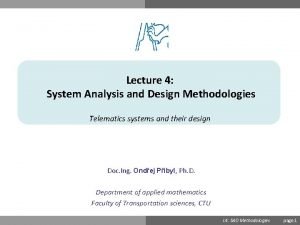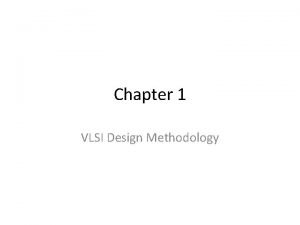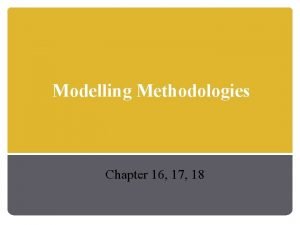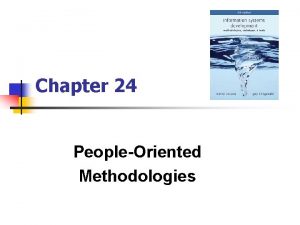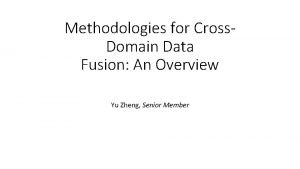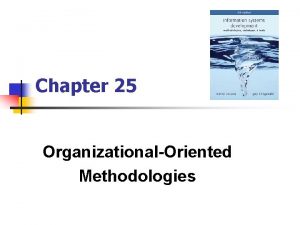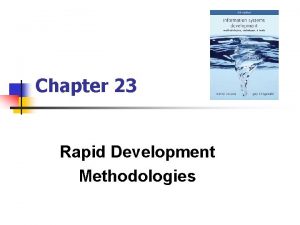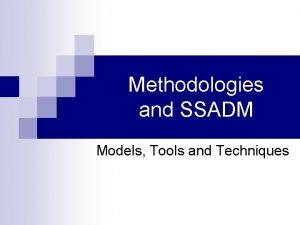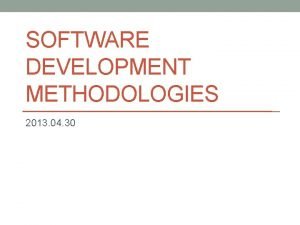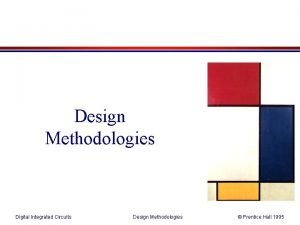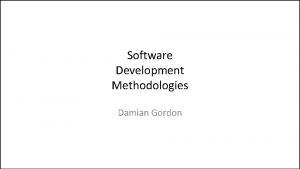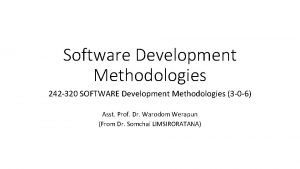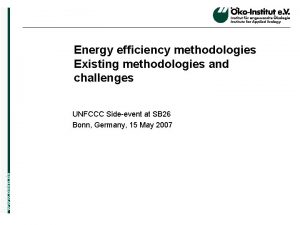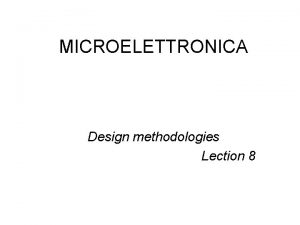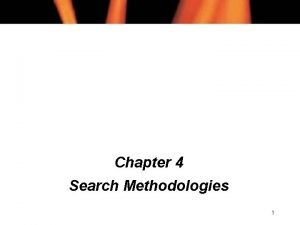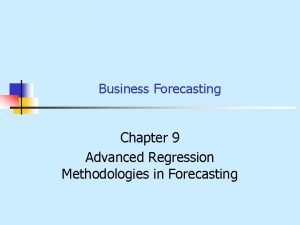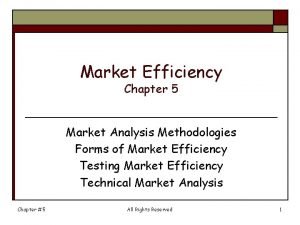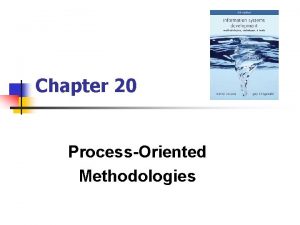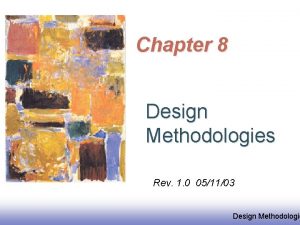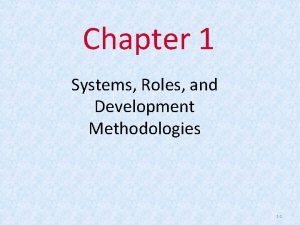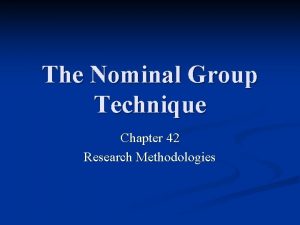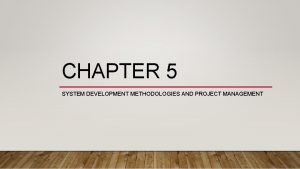Chapter 24 PeopleOriented Methodologies PeopleOriented Methodologies n n























- Slides: 23

Chapter 24 People-Oriented Methodologies

People-Oriented Methodologies n n attempting to capture the expertise and knowledge of the people in the organization methodologies include 1. 2. 3. ETHICS KADS Common. KADS 2

Effective Technical and Human Implementation of Computer-based Systems (ETHICS) (Mumford 1983; 1995) n Philosophy (explicitly stated) n n development of computer systems is not a technical issue but an organizational issues that is fundamentally concerned with the process of change. Based on socio-technical approach n n Mumford: … which recognizes the interaction of technology and people and produces work systems which are both technically efficient and have social characteristics which lead to high job satisfaction Job satisfaction: the attainment of a good ‘fit’ between what employee is seeking from his work – his job needs, expectations and aspirations – and what he is required to do in his job – the organizational job requirements which mould his experience 3

ETHICS n measures for job satisfaction n knowledge fit n n psychological fit n n effort-reward; work controls; supervisionary controls task-structure fit n n fit with status/advancement/interests efficiency fit n n skills/knowledge is being developed/adequately used degree to which tasks are regarded demanding/fulfilling ethical fit n social value fit 4

ETHICS - participation n an essential part of the methodology since ISD is seen as a change process n n “All change involves some conflicts of interest. To be resolved, these conflicts need to be recognized, brought out into the open, negotiated and a solution arrived at which largely meets the interests of all parties in the situation. […] successful change strategies require institutional mechanisms which enable all these interests to be represented, and participation provides these. ” there is not just one way to achieve successful participation, although following issues need to be considered n n n structure (consultative (weakest); representative; consensus (strongest)) content (concerns the issues and boundaries of activities) process (gaining relevant information & knowledge) 5

ETHICS - participation n the use of design group(s) that design the new system, including choice of hw & sw n human-computer interaction n workplace reorganization n allocation of responsibilities (IT specialists are not acting as analysts/designers but educators/facilitators) n n (inappropriate? ) critique – impractical use of ETHICS n n unskilled users cannot do the design properly management task is removed from managers 6

ETHICS (Mumford, 1986) – 15 steps 1. why change? 2. system boundaries 3. description of existing systems groups to define systems) (to help design 4. -6. definition of key objectives and tasks why the particular areas exist? what is their role? what is their purpose? n what should be their responsibilities and functions? n how far do their present activities match what they should be doing? from these key objectives/tasks can be defined n 7

ETHICS – 15 steps 7. diagnosis of efficiency needs n identifying weak links in the existing system 8. diagnosis of job satisfaction needs n through standard questionnaire provided in ETHICS 9. future analysis n as the future system needs to be better than the old one; and to be able to cope with the change (see Leavitt) 10. specifying and weighting efficiency and job satisfaction needs and objectives n n n key step in whole methodology! system objectives are set according to three previous steps; they can often be conflicting; need to be decided and prioritized – all priority objectives need to be included, and as many secondary as possible cannot be done by the design group but requires large 8 participation

ETHICS – 15 steps 11. organizational design of the new system n n if possible, to be performed in parallel with step 12 specifying the data from step 5, and answering following questions, produces an organizational design n n What are the operating activities (day-to-day or regular tasks) that are required? What are the problem prevention/solution activities? What are the co-ordination activities that are required within the design area and between it and other areas? What are the development activities? What are the control activities? What are the special skills required? Are there any key roles or relationships to which particular attention must be paid in the design of the new system? each organizational option is rated according to criteria from step 10 (efficiency; job satisfaction; future change objectives), and should include n sections, subsections, workgroups, individuals, their responsibilities, and tasks 9

ETHICS – 15 steps 12. technical option n specifying different technical options: hw, sw, design of UI’s each option is evaluated similarly as organizational options at the end, organizational and technical options are merged 13. preparation of a detailed work design n n as usual; dataflows, tasks, groups, relationships etc. are defined both technical and organizational aspects 10

ETHICS – 15 steps 14. implementation (of the design) 15. evaluation n n checking that the implemented system meets its objectives (particularly efficiency and job satisfaction) after some time, a need for a new change emerges, thus the development becomes cyclical process 11

Quick. Ethics Mumford has used a version for requirements definition (QUICKETHICS) • • Self-reflection Self-identification Group discussion Group decision §ETHICS is flexible and has evolved over time as experience in its use in different situations has developed (action research). 12

KADS Knowledge Acquisition and Documentation Structuring KADS ia a structured way of developing knowledge-based systems (expert systems). It was developed at the University of Amsterdam as an alternative to an evolutionary approach and is now accepted as the European standard for knowledge based systems. Its components are: n n n A methodology for managing knowledge engineering projects. A knowledge engineering workbench. A methodology for performing knowledge elicitation. KADS was further developed into Common. KADS. 13

Models and processes of KADS • • • Organizational model Application model Task model Model of cooperation Model of expertise 14

Spiral lifecycle model of KADS 15

Categories of Knowledge n n Domain knowledge Inference knowledge Task knowledge Strategic knowledge 16

KADS four layer model for modelling expertise 17

Common. KADS n Common. KADS is a methodology to support structured knowledge engineering. It has been gradually developed and has been validated by many companies and universities in the context of the European ESPRIT IT Programme. It now is an european de facto standard for knowledge analysis and knowledge-intensive system development, and it has been adopted as a whole or has been partly incorporated in existing methods by many major companies in Europe, as well as in the US and Japan. 18

Common. KADS 19

Common. KADS Organization model n supports analysis of an organization, n Goal: discover problems, opportunities and possible impacts of KBS development. Task model n describes tasks that are performed or will be performed in the organizational environment Agent model n describes capabilities, norms, preferences and permissions of agents (agent = executor of task). Knowledge model n gives an implementationindependent description of knowledge involved in a task. Communication models the communicative transactions between agents. Design model n describes the structure of the system that needs to be constructed. 20

Common. KADS Three main stages in the construction of a knowledge model: n Knowledge identification Knowledge specification n Knowledge refinement n 21

Knowledge transfer in common. KADS 22

Thank You for Your Attention 23
 Features of an application letter
Features of an application letter Types of quantitative research designs
Types of quantitative research designs System analysis and design methodologies
System analysis and design methodologies Look up table in fpga
Look up table in fpga Agile methodologies wiki
Agile methodologies wiki Data modelling methodologies
Data modelling methodologies Task model
Task model What is domain
What is domain Indigenous methodologies
Indigenous methodologies Business performance management methodologies
Business performance management methodologies Methodologies for cross-domain data fusion: an overview
Methodologies for cross-domain data fusion: an overview The red tent summary
The red tent summary The great gatsby chapter 8 summery
The great gatsby chapter 8 summery Chapter 10 chemical reactions answer key
Chapter 10 chemical reactions answer key Chapter 11 stoichiometry assessment answer key
Chapter 11 stoichiometry assessment answer key Chapter 9 study guide chemical reactions
Chapter 9 study guide chemical reactions Chapter 7 similarity
Chapter 7 similarity Chapter 6 career readiness chapter review answers
Chapter 6 career readiness chapter review answers 7 ionic and metallic bonding
7 ionic and metallic bonding Chapter 9 surface water chapter assessment answer key
Chapter 9 surface water chapter assessment answer key Chapter 2 assessment physics answers
Chapter 2 assessment physics answers Chemistry the central science 14th edition
Chemistry the central science 14th edition Chapter 7 ionic and metallic bonding chapter answer key
Chapter 7 ionic and metallic bonding chapter answer key Chapter 4 section 1 population dynamics
Chapter 4 section 1 population dynamics


